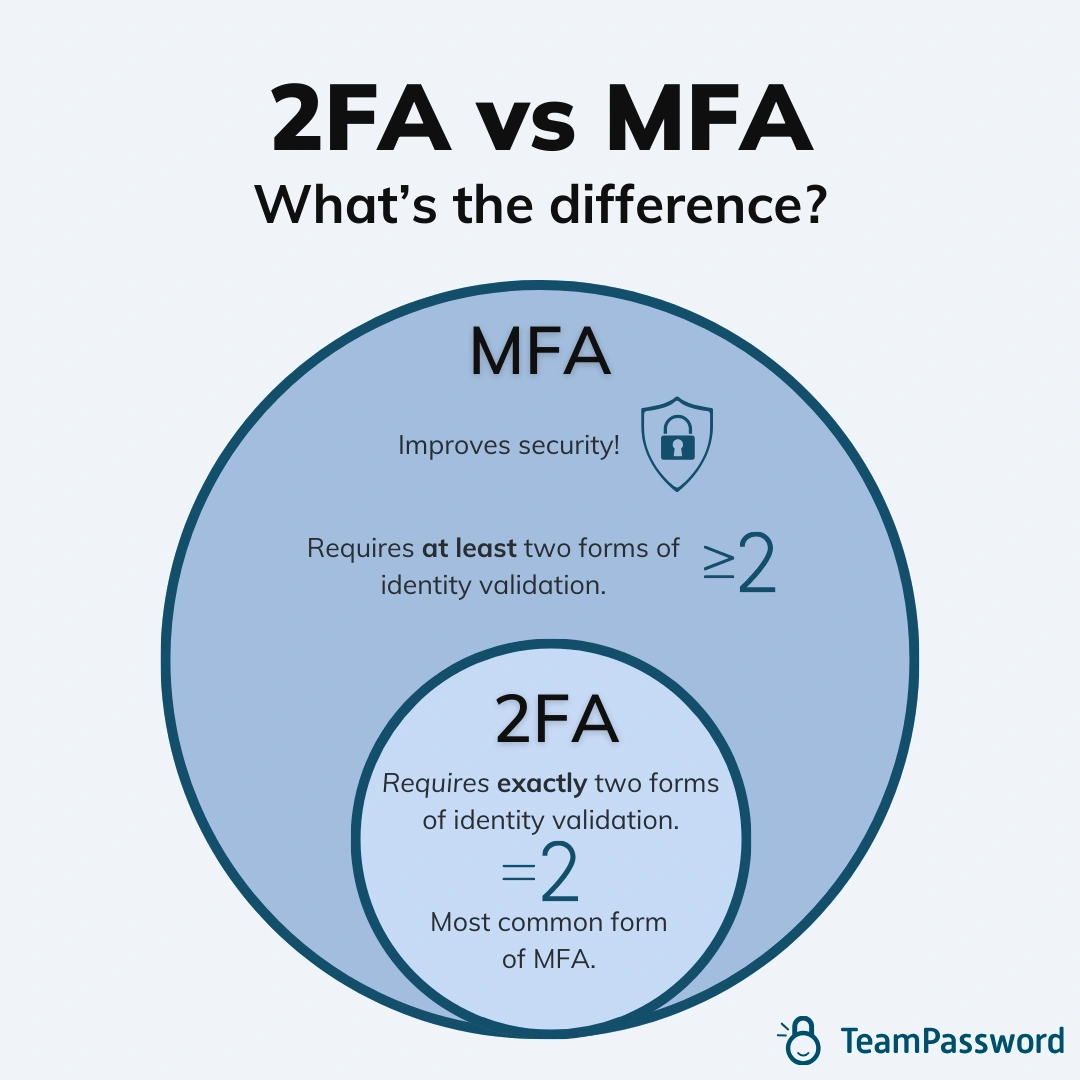2FA vs MFA: Are they the same?
Two-factor authentication (2FA) and multi-factor authentication (MFA) are both ways to improve the security of accounts by requiring more than one way to prove you have permission to access the account. While 2FA requires exactly two forms of authentication, MFA requires at least two forms of authentication. When choosing 2FA vs MFA, the common view is that more is always better (in this case, more secure).
However, since some forms of authentication are inherently stronger than others, it’s often the case that the right form of 2FA provides more security with less aggravation than the wrong method of MFA.
Here’s everything you need to know to choose MFA vs 2FA.
TeamPassword makes it easy to access accounts through the latest MFA technology. Don’t believe us? Sign up for a 14-day free trial today and try TeamPassword's integrated TOTP authenticator for yourself.
Table of Contents
What is authentication?
Authentication is the way a user proves their identity. There are many ways to prove one’s identity, the most common being to type in a username and password.
Authentication can be broken down into three categories based on the number of ways a person must prove their identity:
-
Single-factor authentication (SFA)
-
Two-factor authentication (2FA)
-
Multi-factor authentication (MFA)
What is single-factor authentication?
Single-factor authentication (SFA) requires a user to validate their claimed identity in a single way, usually a username and password. This is the least secure form of authentication and comes with all the issues associated with passwords.
More recently, many mobile devices use biometrics as a single-factor authentication.
What is two-factor authentication?
Two-factor authentication (2FA) requires a user to validate their claimed identity in exactly two ways. The first method is often a username and password, while the second form is more varied. The most common secondary factors are SMS, email, and authenticator app one-time password (OTP) codes.
2FA is far more secure than SFA because passwords can be pwned (that is, leaked online for hackers to exploit).
What is multi-factor authentication?
Multi-factor authentication (MFA) requires a user to validate their claimed identity in at least two ways. This is different from 2FA, in which exactly two methods are required to prove a user’s claimed identity.
While MFA requires at least two forms of identity validation, in reality it often defaults to two methods. In that sense, more often than not, MFA is simply 2FA.
Furthermore, while some cybersecurity experts will claim that having more factors of authentication is always better, the reality is that some are inherently more secure, making further factors redundant and tedious.
However, when different types of authentication factors are chosen, then MFA requiring three or more factors will create a more secure login than 2FA.
Types of secondary authentication factors
To understand the different types of secondary authentication factors, simply remember the word PICK:
-
Possession factors
-
Inherence factors
-
Context factors
-
Knowledge factors
Possession factors
Possession authentication factors are things the user has. The most common possession factors are different types of one-time passwords (OTP), for example codes being sent to an authentication app, email address, or SMS.
Other forms of possession factors include special hardware. For example, you may need a security key, smart card, or cryptographic thumb drive.
Types of possession factors:
-
Email codes
-
SMS codes
-
Authentication app codes
-
Phone calls to your listed phone number
-
Smart card
-
Security key
-
Cryptographic thumb drive
Inherence factors
Inherence authentication factors are things the user is. The most common forms are biometrics data. Face ID and fingerprints are the least exotic inherence factors, but newer forms include iris scans, voice commands, or even gait recognition.
Types of inherence factors:
-
Fingerprints
-
Facial recognition
-
Iris scan
-
Voice command
-
Gait recognition
Context factors
Context authentication factors are based on where the user is. The most common context factors are geographic, for example requiring a user to be in a particular country, logged into a particular network, or using a secure company VPN, to be able to access their accounts.
Furthermore, some accounts may only be accessible at certain times, for example Monday to Friday during work hours.
Types of context factors:
-
Originating country
-
Network connection
-
VPN connection
-
Time of day
-
Day of week
Knowledge factors
Knowledge authentication factors are based on what the user knows. Besides usernames and passwords, separate PIN codes are a common form of knowledge factor. However, the most common form of knowledge factor is personal questions:
-
What was the name of your first school?
-
What street did you grow up on?
-
What was the name of your first boss?
-
What was the name of your first pet?
Social engineering attacks have made many knowledge factors obsolete and unsafe. Therefore, knowledge factors are mostly unused today, at least by high-security businesses.
Types of knowledge factors:
-
Username and password
-
PIN codes
-
Personal questions
Difference between 2FA and MFA
Two-factor authentication requires exactly two forms of identity validation, whereas multi-factor authentication requires at least two forms of validation. In this sense, all 2FA is MFA but not all MFA is 2FA.
Many people might be wondering if MFA really is different from 2FA in practice. In fact, it is incredibly rare for a login to require more than two forms of authentication. That’s because the added value of a third form of authentication is often marginal, while the added time and aggravation are strongly felt.
However, the value is really only marginal when the tertiary authentication is from the same category as the secondary one, or it is a less secure form of authentication.
Is MFA better than 2FA?
In most cases, MFA defaults to 2FA. In many others, MFA doesn’t contribute an appreciable amount of added security, but it still exerts a cost on users in the form of time wasting and frustration. However, there are situations in which the third (or fourth, fifth, …) authentication step does add another layer of security and is justified by the requirements of the business.
Let’s look at three scenarios to see how MFA can be beneficial or redundant.
Scenario 1: Two inherence forms of secondary authentication
In this scenario, proving your identity requires three steps:
-
Username and password
-
Fingerprint
-
Facial recognition
In this case, we can say that Steps 2 and 3 are redundant. Both are hard to fake, meaning that a hacker couldn’t exploit them without abducting the user, in which case they’d have access to both the user’s finger and face. In this case, MFA provides little added value over 2FA.
Scenario 2: One strong and one weak form of secondary authentication
In this scenario, proving your identity requires three steps:
-
Username and password
-
Facial recognition
-
Security question
In this case, security questions are often easily searchable information. If the data cannot be found on the user’s social media, it can often be deduced by calling a relative or friend. The added security gained from requiring a user to answer security questions is so low that this becomes a frustrating and unnecessary third step.
Scenario 3: Two strong and varied forms of secondary authentication
In this scenario, proving your identity requires three steps:
-
Must be connected to the company’s network
-
Username and password
-
One-time password (OTP) through an authenticator app
In this case, the company has used two non-redundant and very strong forms of authentication (context and possession) to ensure only authorized users may gain access to their information. While this could be overkill for some businesses, for others, especially those with a history of ransomware attacks, this added level of security is justified.
2FA or MFA improves security
There are many issues with passwords:
-
Hard to remember
-
Easily hacked by computers
-
Reused by users
-
Not changed often enough
This makes them a weak form of authentication. Cybersecurity professionals use 2FA and MFA to make up for the shortcomings of passwords by adding another step to the identity validation process.
A password manager goes one step further. Instead of requiring you to spend time authenticating multiple accounts, TeamPassword keeps all of your passwords secure behind a strong 2FA wall.
We create, store, and share your account passwords securely so you don’t need to remember hundreds of passwords, or fall into the trap of using the same password for hundreds of accounts.
TeamPassword lets you enforce 2FA protection for you password vault, so that all users must set up authentication to access TeamPassword. Sign up for a 14-day free trial today and try for yourself!



